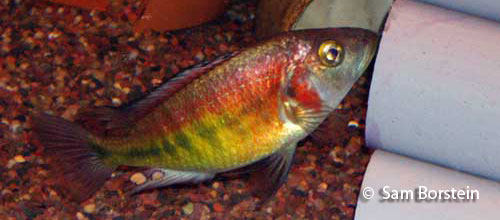Cleptochromis parvidens
(Boulenger, 1911)
Synonyms: Haplochromis parvidens, Lipochromis parvidens



Above: A male Cleptochromis parvidens "Red". Photo by Rick Borstein.
Etymology:
Genus- Clepto= from kleptos (alternate spelling cleptos), to steal, referring to the feeding behavior (Greek), chromis= a fish, perhaps a perch (Greek).
Species- parvus= small (Greek), dens= tooth (Greek).
Intro:
Cleptochromis parvidens is a very interesting Victorian Cichlid. This fish is a mouthbrooder that has a very interseting feeding technique. Cleptochromis parvidens is a paedeophage, meaning it eats the fry and eggs of other mouthbrooding cichlids. Although Cleptochromis is currently a sub genus for some Lipochromis species, it is pretty obvious that fish of the Cleptochromis genera are different, and in my opinion deserve to be elevated from a sub genus to a genus.
Distribution:
This fish is found in Lake Nawampsa, a satellite lake of Lake Victoria.
Size, Maturity, and Sexual Dimorphism:
Size: Males- 8 inches, Females- 7 inches
Maturity: 4 inches
Sexual Dimorphism: Males are larger than females, and have red and yellow on the flanks, while females are silver.

Above: A female Cleptochromis parvidens "Red". Photo by Rick Borstein.
Care:
This fish is easy to care for. They can be aggressive, but will never injure a fish seriously. Be aware that this fish does attain a large size, when you chose tankmates for it.This fish does best in a group. A group of 5 at about breeding age could be kept in a 75 with other cichlids. It's important to take into acount the feeding behavior of this species (see below) when selecting tankmates. I would not recommend keeping this species with other mouthbrooders if you are attempting to breed the other fish.
Diet:
Cleptochromis parvidens are paedeophages, but will accept any food in the aquarium.Like said above, this fish is a paedeophage, meaning it is an egg and fry robber. Scientists believe that Cleptochromis species chase holding females and tire them out, and then use their large mouths to get around the mouth of holding Haplochromis, and suck out the fry, or eggs.
Although this may be how some Cleptochromis obtain their food in the wild, I don't believe this is how Cleptochromis parvidens obtains food. I believe Cleptochromis parvidens is a "bump predator". What I mean by this is that this fish swims into the buccal cavity of holding fish, forcing them to spit their eggs or fry, and then eat them while they are in the water column.
Some support for my belief is my trouble getting my Metriaclima greshakei to breed. The Metriaclima greshakei, which were kept with my Cleptochromis sp. parvidens would breed, but never hold. I was very curious. One thing I did notice was the way my Cleptochromis sp. parvidens swam when the Metriaclima greshakei were holding. They swam almost vertical! I found this to be interesting, but even more interesting was when I saw one of the Cleptochromis sp. parvidens males shoot right up into a holding female Metriaclima greshakei, and miss three times. At this point I decided to strip the Metriaclima greshakei, as I believed the Cleptochromis parvidens were trying to get a quick and easy snack.
Breeding:
This fish wasn't hard to breed, but it definitely was not a prolific spawner. It took a long time for the Cleptochromis parvidens to reach maturity. It takes females quite a bit of time to produce eggs and become gravid.
Females are good holders and will hold for 18-22 days. Fry are not that large and are in numbers of 18-30 per clutch. The fry are prone to bloat if fed lots of protein which makes them difficult to raise. A good crushed spirulina flake should be added to the diet of the fry..

Above: A male Cleptochromis parvidens "Red" in breeding color. Photo by Sam Borstein.
Conclusion:
Cleptochromis parvidens is a really neat Victorian. Its behavior is very unique and fun to watch. You are going to have to look around for this fish, as you will not find it at you local pet shop and probably will not find it in your club. If you keep Vics and want to try one that is different, try this fish out.
References:
- Boulenger, G. A. (1911) On a third collection of fishes made by Dr. E. Bayon in Uganda, 1909-1910 (Collezioni zoologiche fatte nell'Uganda dal Dott. E. Bayon. XII.). Annali del Museo Civico di Storia naturale di Genova, 5, 64-78.
- IUCN. IUCN Red List of Threatened Species. <http://www.iucnredlist.org>.
